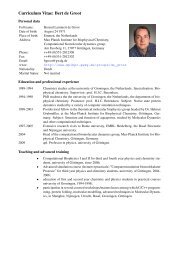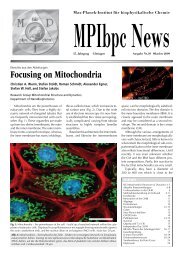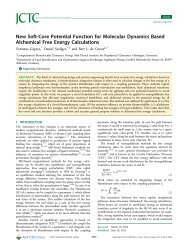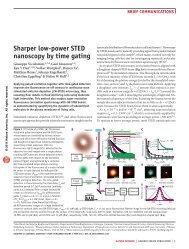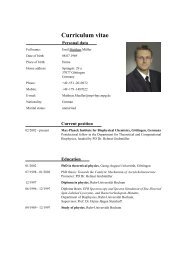Elastic Properties of Photoswitchable Azobenzene Polymers from ...
Elastic Properties of Photoswitchable Azobenzene Polymers from ...
Elastic Properties of Photoswitchable Azobenzene Polymers from ...
You also want an ePaper? Increase the reach of your titles
YUMPU automatically turns print PDFs into web optimized ePapers that Google loves.
Zuschriften<br />
azobenzene monomer and the number <strong>of</strong> individual monomers.<br />
To resolve this discrepancy, and, more generally, to<br />
obtain a detailed understanding <strong>of</strong> the underlying polymer<br />
mechanics at the atomistic scale, we carried out explicitsolvent<br />
force-probe molecular dynamics (MD) simulations<br />
[25,26] <strong>of</strong> polyazobenzene model peptides under mechanical<br />
stress, the results <strong>of</strong> which resemble those <strong>of</strong> the AFM<br />
experiments described in Figure 1c. The simulations provided<br />
detailed mechanistic insight that is prerequisite for the<br />
efficient and targeted optimization <strong>of</strong> photoswitchable polymers<br />
for future applications in nanotechnology. Because we<br />
were only interested in the elastic properties <strong>of</strong> these model<br />
polymers, and not in the photoisomerization kinetics, we kept<br />
the azobenzenes fixed in the cis or trans conformation during<br />
the simulations. We did not include the photoisomerization<br />
itself into our simulations on the assumption that this process<br />
occurs on a much faster time scale than the subsequent<br />
structural rearrangement <strong>of</strong> the polymer. Indeed, sub-picosecond<br />
kinetics have been observed for azobenzene photoisomerization,<br />
[27, 28] a complex process that involves several<br />
energy surfaces. [27–33]<br />
By comparing our simulations to the AFM experiments,<br />
we gleaned insight into the overall elastic properties <strong>of</strong><br />
azobenzene polymers and could relate our results directly to<br />
the measured elasticity characteristics. We were able to<br />
elucidate the crucial role <strong>of</strong> the peptides that interlink the<br />
azobenzene units and to predict the elastic behavior beyond<br />
the experimentally accessible force regime. Finally, we used<br />
the detailed mechanistic understanding thus obtained to<br />
design a photoswitchable polyazobenzene peptide with<br />
improved optomechanical properties.<br />
The model azobenzene polymers used in our simulations<br />
were constructed <strong>from</strong> four azotripeptide units (n = 4 in<br />
Figure 1b). These (Lys-Azo-Gly) 4 dodecamers have the same<br />
stoichiometry as the polymers used in the AFM studies. As in<br />
the experiments, DMSO was used as a solvent. To study the<br />
effect <strong>of</strong> the azobenzene conformation (cis or trans) on the<br />
elastic properties, we considered three stereochemically<br />
different polymers, an all-cis, an all-trans, and a mixed cis–<br />
trans–cis–trans system. The mixed polymer was considered<br />
because complete photoisomerization upon optical pumping<br />
was not achieved in the experiments as a result <strong>of</strong> the<br />
overlapping absorption bands <strong>of</strong> the cis and trans states. [22,23]<br />
A study <strong>of</strong> this polymer would also reveal possible cooperative<br />
effects between adjacent monomers.<br />
The force-versus-extension traces obtained <strong>from</strong> the AFM<br />
experiments reflect the elastic properties expected for a<br />
polymer subjected to a mechanical load. Figure 2a shows the<br />
overall force-extension traces <strong>of</strong> the all-cis, all-trans, and<br />
mixed azobenzene model polymers obtained <strong>from</strong> our forceprobe<br />
MD simulations (over 50–70 ns each). These traces<br />
closely resemble the curves <strong>from</strong> the AFM experiments<br />
(Figure 2a, inset). [22,23] At higher forces above 600 pN, deviations<br />
<strong>from</strong> the wormlike-chain (WLC) behavior are seen.<br />
These deviations are discussed below. As expected, the force<br />
trace <strong>of</strong> the mixed cis–trans–cis–trans polymer lies midway<br />
between those <strong>of</strong> the all-cis and the all-trans polymers. This<br />
result already suggests that cooperative effects between<br />
monomers are unlikely. Therefore, such effects cannot<br />
Figure 2. Force-probe MD force-extension curves for (Lys-Azo-Gly) 4,<br />
obtained at a pulling velocity <strong>of</strong> 0.1 nm ns 1 . a) Curves <strong>of</strong> the all-cis<br />
(blue), all-trans (red), and mixed cis–trans–cis–trans polymers (black).<br />
The overall extension is defined as the distance between the C terminus<br />
and the N terminus along the pulling direction. The extension<br />
difference obtained <strong>from</strong> a WLC fit (smooth lines) <strong>of</strong> 1.45 Š per unit<br />
between the cis and trans polymers (at 200 pN) is shown as a green<br />
dashed line. Arrows indicate events discussed in the text. Inset: WLC<br />
curves obtained <strong>from</strong> experiment (black line) [23] and simulation (red<br />
dashed line) for the all-trans polymer, for the contour length <strong>of</strong><br />
L c = 89.1 nm taken <strong>from</strong> ref. [23]. b) The output <strong>of</strong> mechanical work<br />
(blue trapezoid) due to “optical” contraction against an external load<br />
increases with the extension difference, DL, which is the extension<br />
difference per monomer, Dl, multiplied by the number <strong>of</strong> monomers,<br />
n. The cantilever stiffness is reflected in the slope <strong>of</strong> the dashed black<br />
line. c, d) Force-extension curves <strong>of</strong> the individual polymer building<br />
blocks azobenzene (c), lysine (d), and glycine (d, inset). The smooth<br />
lines represent 100000-point averages. For the definition <strong>of</strong> the<br />
boundaries <strong>of</strong> the individual monomers, see the Supporting Information.<br />
explain the unexpectedly small length changes observed in<br />
the AFM experiments.<br />
The force field and simulation protocol used were<br />
validated by comparison with the AFM results. To this end,<br />
the force-probe MD force-extension data were modeled using<br />
an extended WLC model, [34] WLC model [Eq. (1)], [34]<br />
FðrÞ ¼ k BT<br />
L p<br />
1<br />
4 1<br />
r<br />
Lc 2<br />
1 r<br />
þ<br />
4 Lc , ð1Þ<br />
in which F is the force, T = 300 K the temperature, r the<br />
polymer extension, L c the contour length, and L p the<br />
persistence length. Table 1 lists the WLC parameters<br />
obtained as well as the extension difference per switched<br />
azobenzene monomer, Dl, for all simulated systems, together<br />
with the values obtained <strong>from</strong> experiment.<br />
Because experimental WLC data are only accessible for<br />
the all-trans polymer, [23] we compare in Table 1 only the<br />
parameters <strong>of</strong> the all-trans polymers. The contour length L c<br />
per azotripeptide unit given in reference [22] was not<br />
extracted <strong>from</strong> the measured force traces, but determined<br />
by molecular modeling. Therefore, we only compare the<br />
2 www.angewandte.de 2007 Wiley-VCH Verlag GmbH & Co. KGaA, Weinheim Angew. Chem. 2007, 119, 1–7<br />
Ü<br />
Ü<br />
These are not the final page numbers!




